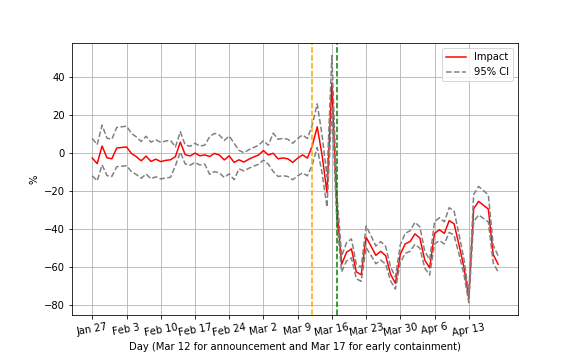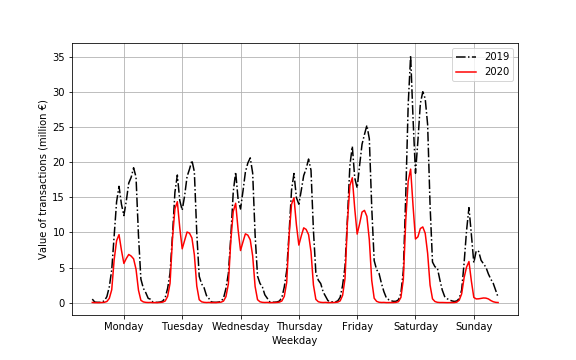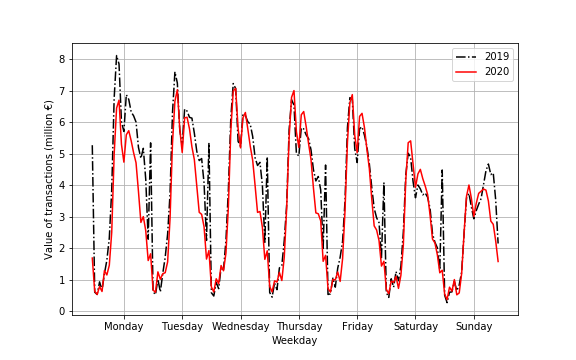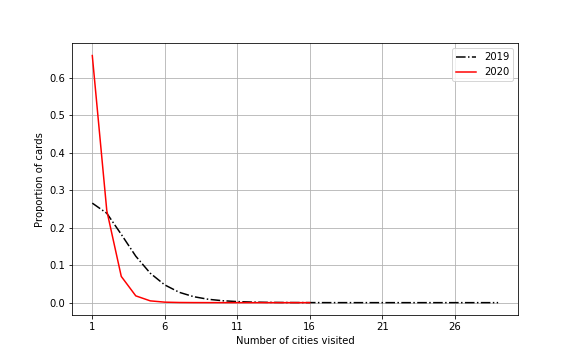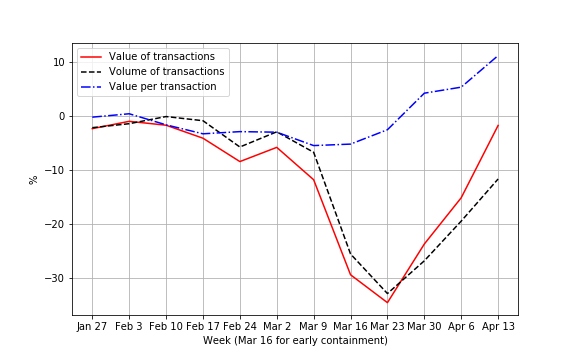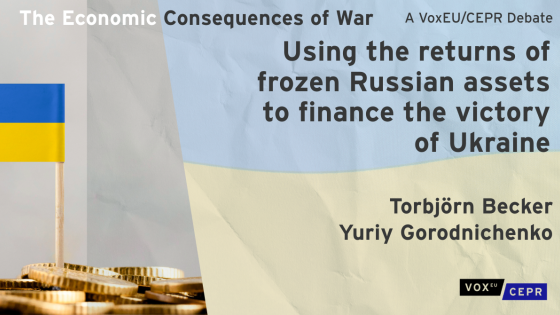The COVID-19 pandemic is having a dramatic effect on individuals and economies. Policymakers have needed to respond quickly, and indeed the question of appropriate policy responses immediately attracted the attention of economists (e.g. Baldwin and Weder di Mauro 2020a,b). Official economic data have, however, lagged events, as they inevitably do. As a result, many researchers have turned to new high-frequency data sources to follow the pandemic and its effects. Consumer transaction data from banks or other financial institutions have proven to be one of the most fruitful sources, and have been studied by, among others, Andersen et al. 2020 (for Denmark), Baker et al. 2020 (for the US), Carvalho et al. 2020 (for Spain), Chen et al. 2020 (for China).
In Bounie et al. (2020), we use data for France (thanks to a partnership with Groupement des Cartes Bancaires CB, providing billions of anonymised card transactions). By following the expenditures on individual bank cards, we can track changes in individuals’ consumption, their movements from a home city or region, and the degree to which consumers have been able to blunt the impact of the containment restrictions through recourse to online shopping. Each of these tells us something important about the impact of the restrictions mandated by the French government, about consumer behaviour, and possibly about preparedness for future shocks to the economy.
Consumer expenditure dynamics
We are able to follow about 70 million cardholders, and about 4.5 billion transactions, through 2019 and into 2020. The periods from the beginning of January through early March were very similar in the two years; both the patterns and the absolute numbers are sufficiently close for it to be difficult to distinguish between them in graphical representations. However, from the time of the announcement of the official containment (to take effect on 17 March 2020), the data from the two years begin to differ radically. Immediately preceding the containment, we see a clear spike in spending, as consumers anticipated the closure of many retailers, followed by a rapid decline as the containment begins. The extent of the decline in aggregate value transacted in the first weeks was approximately 60%, which was somewhat less than the decline in aggregate transaction volumes, because average value per transaction increased. The fall in consumption is greater than that observed in previous work in Denmark (-25%), China (-32%), Spain (-49%) or the US (-50%). Figure 1 plots the daily dynamics of transaction values and average values per transaction through the initial containment period.
Figure 1 Estimated daily spending response dynamics
a) Value
b) Value per transaction
The data also permit us to examine the pattern of expenditure within the day, both online and point-of-sale (Figure 2). The online and off-line contrast is substantial, although both show expenditure declines overall.
Figure 2 Intra-week consumption fluctuations, online versus offline during containment, January-April 2019 and 2020
a) Offline
b) Online
However, although we see that online consumption also declined during the containment period, this masks a good deal of variation across sectors, containing interpretable patterns which we describe below.
Mobility during the containment
The period of containment required individuals to stay home as much as possible barring essential purchases such as food, and it is possible to observe the effects of these restrictions on individuals’ movements through point-of-sale transactions on bank cards. By imputing a home base to each card as the geographical location in which most purchases were made, we can observe the proportion of transactions made away from the home base, the distribution of distance travelled per card, and also the number of other French cities, towns or départements, or retailers which were visited by individual cardholders. The distributions are virtually identical for the pre-containment dates (January through early March) in 2019 and 2020; however, comparing the post-containment dates from 17 March onward in 2019 and 2020 (Figure 3), we observe a clear effect of the compliance of French citizens with the containment directives.
Figure 3 Distances travelled by cards and card mobility by number of cities
a) Distance travelled
b) Cities visited
Average distance travelled was only about one quarter as much during the containment period as in the analogous period in the previous year; during the containment period about 65% of cards were used in a single city, whereas only 26% confined purchases to a single city in the comparable period of 2019. Other measures, such as the number of retailers visited and the value of transactions completed outside the home location, show similar results: consumers restricted their mobility substantially in response to the containment directives.
Online purchases and substitution
The degree to which the economy is resilient to shocks is important for individual welfare and deserves to be, in our view, an important goal of policy. The availability of alternative ways of making purchases certainly contributes to resilience when, as in the present circumstances, some of the usual retail outlets are unavailable. However, in the aggregate data (Figure 4, weekly frequency) we see that online expenditures also declined, albeit by less than traditional point-of-sale expenditures (roughly a 30% decline online versus 60% at point-of-sale), which at first may seem incompatible with substitution toward the online alternative. However, this masks important differences across types of purchase.
Figure 4 Estimated weekly response of offline and online consumption spending
a) Offline
b) Online
In order to understand what is happening, it is necessary to look at a sectoral decomposition of consumer expenditures by category, which fortunately is possible using the detailed CB data. In doing so, we see that part of the decline in online expenditure is the result of the elimination of online bookings and payments for expenditure categories such as travel, hotels, and some restaurant expenditures, which were restricted by the conditions of the containment. Other sectors show varying patterns; here, we give two examples of essential and non-essential activities (Figure 5) among many recorded in the full paper.
Figure 5 Weekly sectoral expenditure response dynamics: Example of an essential and non-essential business
a) Supermarkets
b) Clothing
Purchases of food from supermarkets increased both online and in physical stores, as fewer restaurant meals were consumed; online sales increased much more substantially. Clothing sales provide a contrasting example; sales in physical stores essentially stopped entirely, and while online sales also declined initially, the online option meant that the availability of clothing was maintained. Similarly, online information technology sales also increased rapidly during the containment, while sales in stores declined precipitously.
The detailed decomposition by type of expenditure shows that for categories in which online purchase and physical delivery is possible, online expenditures often increased, in some cases very substantially, suggesting substitution in the direction of online purchases. Nonetheless, a wide variety of patterns is observable across sectors.
Conclusions and evolution of this research
Transaction data can provide very valuable information to policymakers, especially when they contain geographical information and detailed product categories, and that too in real time. In the present circumstances, the data reveal information about the extent of the consumption decline, consumers’ anticipation of changes, adjustment along the margin of average transaction value, differences across sectors, and the extent of online/off-line substitution. Studying the present crisis and the differences in policies across countries will contain lessons for future responses, and for the design of institutions and policies that can potentially make the economy more resilient to shocks.
As the pandemic evolves and restrictions on consumers and businesses evolve as well, our paper will be updated to trace the dynamic path of adjustment to the crisis.
References
Andersen, A L, E T Hansen, N Johannesen and A Sheridan (2020), “Consumer responses to the COVID-19 crisis: Evidence from bank account transaction data”, COVID Economics 7, 88-114.
Baker, S R, R A Farrokhnia, S Meyer, M Pagel and C Yannelis (2020), “How does household spending respond to an epidemic? Consumption during the 2020 COVID-19 pandemic”, NBER working paper 26949.
Baldwin, R and B Weder di Mauro (2020a), Economics in the time of COVID-19, London: CEPR Press, VoxEU.org eBook.
Baldwin, R and B Weder di Mauro (2020b), Mitigating the COVID Economic Crisis: Act Fast and Do Whatever it Takes, London: CEPR Press, VoxEU.org eBook.
Bounie, D, Y Camara and J W Galbraith (2020), “Consumers' mobility, expenditure and online- offline Substitution response to COVID-19: Evidence from French transaction data”, Available at SSRN.
Carvalho, V, S Hansen, A Ortiz, J R Garcia, T Rodrigo, J V Rodriguez Mora and P Ruiz (2020), “Tracking the Covid-19 crisis with high-resolution transaction data”, CEPR discussion paper 14642.
Chen, H, W Qian and Q Wen (2020), “The impact of the Covid-19 pandemic on consumption: learning from high-frequency transaction data”, Working paper.




